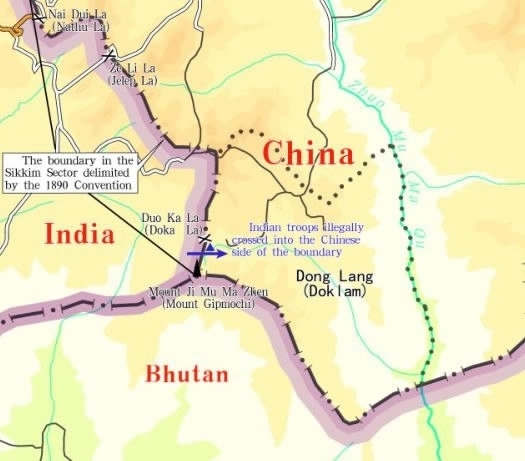China-India border impasse and Doklam standoff

Commentary:
India to face the consequences of its strategic miscalculation
Xinhua —-
It has now entered the third month since Indian military trespassed into Chinese territory, to which China has shown the utmost tolerance. India must take any possible consequences if it continues to miscalculate the situation.
On June 18, over 270 armed Indian troops with two bulldozers crossed the eastern boundary into Doklam, China’s sovereign territory, to obstruct Chinese infrastructure construction.
It is a double standard, as India has approved the building of a military road to facilitate troop deployment near the western part of China-India border to “ensure the strength of the Indian border troops.”
On Aug. 22, Chinese troops, patrolling on the Chinese side of Pangong Lake, suffered injuries from the reckless actions of Indian troops, which once again reflected India`s insincerity and self-contradictions in resolving the Sino-India border issue peacefully.
A senior Indian official has said that the country has not attacked any other country and has no ambition to expand its boundaries.
However, the Indian military has trespassed over the mutually recognized boundary that has been abided by both sides for nearly 130 years and its troops remain on Chinese territory.
China has proved its sovereignty of Doklam to the international community with convincing evidence, including the historical convention from 1890.
Meanwhile, China has not closed the door to diplomatic dialogue with India to ease tensions.
Since the 1960s, through negotiation and consultation, China has delimited 20,000 kilometers of land boundary and is in complete accord with 12 out of its 14 land neighbors.
“India thinks that the international situation is good enough for it to test China’s bottom line,” Li Qingyan, an expert on South Asia issues at China Institute of International Studies, told Xinhua.
But India may have miscalculated China’s stance in defending its sovereignty. China’s bottom line is the border line, as shown in the Sino-Indian border conflict in 1962.
China values peace and the interests of innocent people on both side of the border, that is why it has remained patient in the face of such encroachment.
China has never made the first move in wars fought since 1949 but it would not flinch if a war were to be inflicted upon its people.
The prerequisite for settlement of the border standoff is the unconditional withdrawal of all trespassing personnel and equipment to the Indian side.
China has sent this message openly to India through many channels over the past 60 days.
Now, it is time for India to abide by the law, respect historical facts, to match words with deeds and make the wise decision based on reasonable strategic calculation.
China and India are two developing giants with a wide range of common interests. A sensible bilateral relationship will benefit more than two billion people, nearly one-third of the global population.
The ball has been placed in India’s court.
Withdrawal of Indian troops prerequisite for resolving China-India border impasse
Xinhua —
The Indian military’s trespassing into China’s territory has entered the third month, with no signs of the south Asian country withdrawing its troops. The ball is now firmly in India’s court.
The prerequisite for resolving the incident is clear: India must immediately and unconditionally withdraw its trespassing border troops and equipment to the Indian side of the boundary, as the Doklam (Dong Lang) region is undisputed Chinese territory.
Although China is a peace-loving country and firmly upholds peace, it will resolutely defend its national sovereignty and territorial integrity and never allow any country to violate its territorial sovereignty for any reason.
The Doklam area borders India’s Sikkim state to the west and the Kingdom of Bhutan to the south. The boundary has been delimited by the 1890 Convention Between Great Britain and China Relating to Sikkim and Tibet.
Both the Chinese and Indian governments recognize the convention. Each of the two sides for nearly 130 years has exercised jurisdiction over its side of the boundary without any dispute.
No matter what India believes, the fact that it illegally crossed the boundary is clear-cut, rendering any excuse – such as the claim that China’s infrasructure construction activities threaten India’s security – absurd.
Following India’s logic, if China ever feels that India’s infrastructure construction in the border region threatens Chinese security, China can openly send troops to Indian territory to stop it.
It’s odd that while India has its troops broken into its neighbor’s home, it continues to pose as the victim and seeks to garner sympathy.
A boundary is under the protection of international law once it is established by a convention. India’s blatant move not only severely violates China’s territorial sovereignty, but also poses a grave challenge to regional peace and norms governing international relations.
If India’s logic is tolerated, we might as well throw international norms out the window.
So far, China has exercised utmost restraint. As a major country, there is great anticipation that India would make the responsible choice of abiding by the law rather than invoking nationalism.
Spotlight: What’s behind India’s illegal trespassing into China?
by Xia Yuanyi
Chinese border troops have always been committed to upholding peace and tranquility of the China-India border areas, said a Chinese foreign ministry spokesperson Wednesday in response to India’s trespassing into the Dong Lang (Doklam) region on June 18.
Spokeswoman Hua Chunying also urged India to abide by current agreements and treaties.
However, up until now, India has not withdrawn its troops and equipment that have encroached into Chinese territory.
OLD BAG OF TRICKS
Doklam is described as a disputed territory by New Delhi, which is simply untrue.
The Convention Between Great Britain and China Relating to Sikkim and Tibet signed by both countries in 1890 delimited the boundary between the Tibet region of China and the Indian state of Sikkim, which confirmed Doklam is Chinese territory. Successive Indian governments have acknowledged the demarcation.
However, it is not really hard to understand why India has abandoned its previous position. India is again using its old bag of tricks.
“Indians have convinced themselves that if they declare a tract of territory to be Indian, it becomes Indian, which is nonsense,” said Neville Maxwell, an Australian journalist who was on the ground for the British Daily The Times at the time of the Sino-Indian border conflict in 1962.
Maxwell, in an interview with Xinhua, said India has unilaterally claimed sovereignty over pieces of land along its northeastern borders, and now Doklam is next.
India has attempted to justify its incursion on the pretext of “protecting Bhutan,” arguing that Doklam is Bhutanese territory.
The fact is that the Bhutanese authorities have clearly told Chinese officials that Doklam is not Bhutan’s territory and expressed confusion by India’s actions.
As a third party, India has no right to interfere in or impede boundary talks between China and Bhutan, nor does it have the right to make territorial claims on Bhutan’s behalf.
India’s intrusion into Chinese territory under the pretext of protecting Bhutan has not only violated China’s territorial sovereignty, but also challenged Bhutan’s independence.
Obviously, India is not only trying to change the status quo but also misrepresent the truth for its own unspoken intentions.
RECKLESS BEHAVIOR
Wang Jiangyu, an associate professor of law at National University of Singapore, said India is pursuing a hegemony strategy in the region, provoking complaints from smaller countries in South Asia, which won’t dare voice their anger, fearing retaliation from India.
According to Vassily Kashin, a senior research fellow at Russia’s National Research University, India’s illegal trespassing into Chinese territory serves two purposes.
First, India is struggling to emerge from the shadow of China, a rising power to its north. The professor said the rapid pace of many Chinese projects throughout Asia, in particular the Belt and Road Initiative, has triggered concern of China’s regional and global influence. India wrongly believes China has invaded its traditional region of influence.
Second, India hopes to maintain its stronghold in the region, Kashin said. Therefore, it needs to hide its anxiety in the face of China’s rise and prove itself with resolute action. That partly explains why Indian troops recklessly trespassed into Doklam.
The aim of concocting territorial disputes is to flex its muscles against its smaller neighbors, including Bhutan, Nepal, Sri Lanka and Bangladesh, countries where China’s presence has grown in recent years.
The Chinese have long abided by the wisdom of the ancient philosopher Confucius, who said that anyone looking to help himself shall also help others. Unfortunately, India has chosen instead to hurt, not help, its neighbors. Source : Xinhua
Aug. 25.2017












